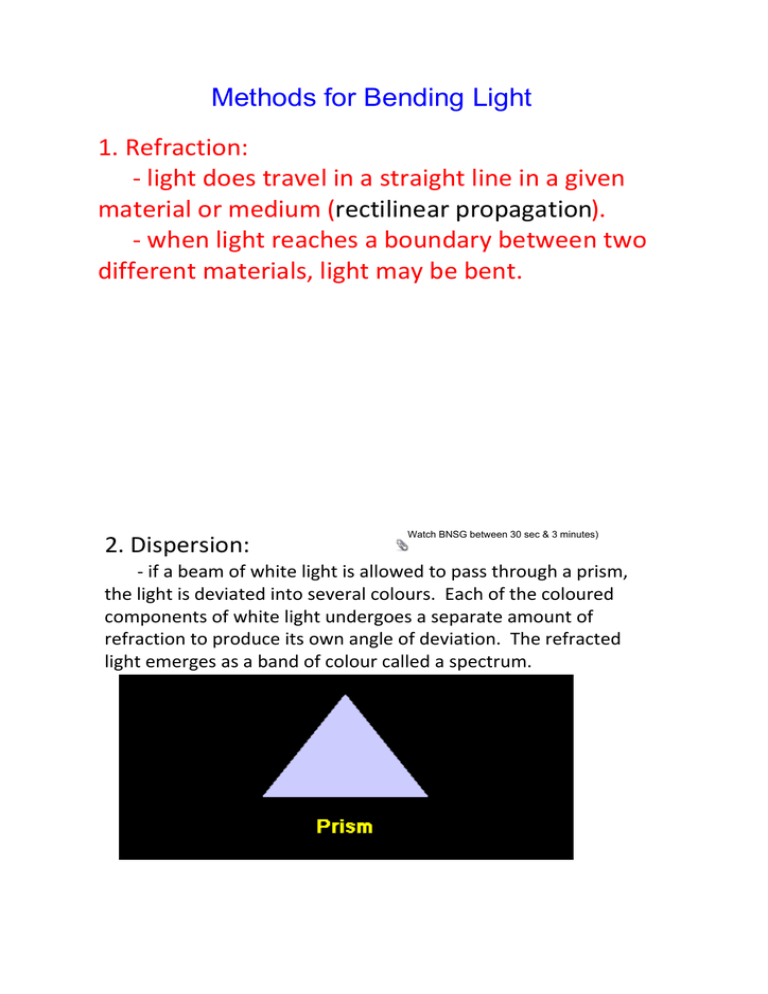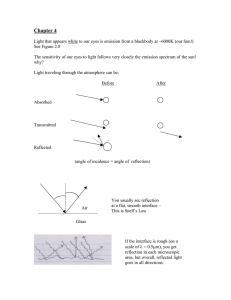1. Refraction: ‐ light does travel in a straight line in a given material
advertisement

Methods for Bending Light 1. Refraction: ‐ light does travel in a straight line in a given material or medium (rectilinear propagation). ‐ when light reaches a boundary between two different materials, light may be bent. 2. Dispersion: Watch BNSG between 30 sec & 3 minutes) ‐ if a beam of white light is allowed to pass through a prism, the light is deviated into several colours. Each of the coloured components of white light undergoes a separate amount of refraction to produce its own angle of deviation. The refracted light emerges as a band of colour called a spectrum. Why is the sky blue? Think about radio waves versus gamma rays http://www.aip.org/pnu/2005/split/736­2.html 3. Scattering: Different from reflection, where radiation is deflected in one direction, some particles and molecules found in the atmosphere have the ability to scatter solar radiation in all directions. The particles/molecules which scatter light are called scatterers and can also include particulates made by human industry. 3. Scattering: Rayleigh scattering occurs when certain particles are more effective at scattering a particular wavelength of light. Air molecules, like oxygen and nitrogen for example, are small in size and thus more effective at scattering shorter wavelengths of light (blue and violet). 3. Scattering: Mie Scattering ­Large particles in the atmosphere are able to scatter all wavelengths of white light equally. ­This is why clouds appear white. ­However, if a cloud is optically thick, then little light will penetrate through the cloud. Why does dusk and dawn appear reddish/orangish? A little bit of diffraction, refraction, and scattering. The light rays travel further, so the blue/violet wavelengths are completely scattered from your view. The atmosphere is a different medium than that of space, so the sun is already out of your view, but the light is refracted towards you. Since the yellow­red wavelengths are longer than the blue/violet, they are able to diffract around most particles in the atmosphere, thus able to travel further. http://apollo.lsc.vsc.edu/classes/met130/notes/chapter19/sunrise_set.html Mirages To understand how a mirage forms, one must first understand how light travels through air. If the air is all the same temperature­­cold or hot­­ light travels through it in a straight line. If a steady temperature gradient exists, however, light will follow a curved path toward the cooler air. Cold air has a higher index of refraction than warm air does. As a result, light travels through hot air faster than they can through cold air because the hot air is less dense. http://www.physics.org/article­questions.asp?id=45 Superior mirage Inferior mirage Applications of Total Internal Reflection 1. Diamonds ­ the sparkle of diamonds is due to this phenomenon. With a high index of refraction, and low critical angle, the light rays that hit a diamond either enter it, or are reflected. Rays that strike at an incident angle less than 24.5° will be reflected and cannot escape. The light ray will strike several sides of the diamond before actually escaping causing the brilliant sparkle (one way you can tell if the diamond is real or not). Diagram: Refer to page 496 and draw in the diagram of the diamond undergoing Total internal reflection. 2. Binoculars – total internal reflection prisms are used in combination with a series of lenses in binoculars to help focus and enlarge the image. Attachments Mirage in Death Valley ­ YouTube [360p].mp4




